Nikos Deligiannis
Member, IEEE
Scalable Context-Preserving Model-Aware Deep Clustering for Hyperspectral Images
Jun 12, 2025Abstract:Subspace clustering has become widely adopted for the unsupervised analysis of hyperspectral images (HSIs). Recent model-aware deep subspace clustering methods often use a two-stage framework, involving the calculation of a self-representation matrix with complexity of O(n^2), followed by spectral clustering. However, these methods are computationally intensive, generally incorporating solely either local or non-local spatial structure constraints, and their structural constraints fall short of effectively supervising the entire clustering process. We propose a scalable, context-preserving deep clustering method based on basis representation, which jointly captures local and non-local structures for efficient HSI clustering. To preserve local structure (i.e., spatial continuity within subspaces), we introduce a spatial smoothness constraint that aligns clustering predictions with their spatially filtered versions. For non-local structure (i.e., spectral continuity), we employ a mini-cluster-based scheme that refines predictions at the group level, encouraging spectrally similar pixels to belong to the same subspace. Notably, these two constraints are jointly optimized to reinforce each other. Specifically, our model is designed as an one-stage approach in which the structural constraints are applied to the entire clustering process. The time and space complexity of our method is O(n), making it applicable to large-scale HSI data. Experiments on real-world datasets show that our method outperforms state-of-the-art techniques. Our code is available at: https://github.com/lxlscut/SCDSC
ReferGPT: Towards Zero-Shot Referring Multi-Object Tracking
Apr 12, 2025Abstract:Tracking multiple objects based on textual queries is a challenging task that requires linking language understanding with object association across frames. Previous works typically train the whole process end-to-end or integrate an additional referring text module into a multi-object tracker, but they both require supervised training and potentially struggle with generalization to open-set queries. In this work, we introduce ReferGPT, a novel zero-shot referring multi-object tracking framework. We provide a multi-modal large language model (MLLM) with spatial knowledge enabling it to generate 3D-aware captions. This enhances its descriptive capabilities and supports a more flexible referring vocabulary without training. We also propose a robust query-matching strategy, leveraging CLIP-based semantic encoding and fuzzy matching to associate MLLM generated captions with user queries. Extensive experiments on Refer-KITTI, Refer-KITTIv2 and Refer-KITTI+ demonstrate that ReferGPT achieves competitive performance against trained methods, showcasing its robustness and zero-shot capabilities in autonomous driving. The codes are available on https://github.com/Tzoulio/ReferGPT
Unlocking Open-Set Language Accessibility in Vision Models
Mar 14, 2025Abstract:Visual classifiers offer high-dimensional feature representations that are challenging to interpret and analyze. Text, in contrast, provides a more expressive and human-friendly interpretable medium for understanding and analyzing model behavior. We propose a simple, yet powerful method for reformulating any visual classifier so that it can be accessed with open-set text queries without compromising its original performance. Our approach is label-free, efficient, and preserves the underlying classifier's distribution and reasoning processes. We thus unlock several text-based interpretability applications for any classifier. We apply our method on 40 visual classifiers and demonstrate two primary applications: 1) building both label-free and zero-shot concept bottleneck models and therefore converting any classifier to be inherently-interpretable and 2) zero-shot decoding of visual features into natural language. In both applications, we achieve state-of-the-art results, greatly outperforming existing works. Our method enables text approaches for interpreting visual classifiers.
Interpreting and Analyzing CLIP's Zero-Shot Image Classification via Mutual Knowledge
Oct 16, 2024Abstract:Contrastive Language-Image Pretraining (CLIP) performs zero-shot image classification by mapping images and textual class representation into a shared embedding space, then retrieving the class closest to the image. This work provides a new approach for interpreting CLIP models for image classification from the lens of mutual knowledge between the two modalities. Specifically, we ask: what concepts do both vision and language CLIP encoders learn in common that influence the joint embedding space, causing points to be closer or further apart? We answer this question via an approach of textual concept-based explanations, showing their effectiveness, and perform an analysis encompassing a pool of 13 CLIP models varying in architecture, size and pretraining datasets. We explore those different aspects in relation to mutual knowledge, and analyze zero-shot predictions. Our approach demonstrates an effective and human-friendly way of understanding zero-shot classification decisions with CLIP.
Learned layered coding for Successive Refinement in the Wyner-Ziv Problem
Nov 06, 2023Abstract:We propose a data-driven approach to explicitly learn the progressive encoding of a continuous source, which is successively decoded with increasing levels of quality and with the aid of correlated side information. This setup refers to the successive refinement of the Wyner-Ziv coding problem. Assuming ideal Slepian-Wolf coding, our approach employs recurrent neural networks (RNNs) to learn layered encoders and decoders for the quadratic Gaussian case. The models are trained by minimizing a variational bound on the rate-distortion function of the successively refined Wyner-Ziv coding problem. We demonstrate that RNNs can explicitly retrieve layered binning solutions akin to scalable nested quantization. Moreover, the rate-distortion performance of the scheme is on par with the corresponding monolithic Wyner-Ziv coding approach and is close to the rate-distortion bound.
Holistic Representation Learning for Multitask Trajectory Anomaly Detection
Nov 03, 2023Abstract:Video anomaly detection deals with the recognition of abnormal events in videos. Apart from the visual signal, video anomaly detection has also been addressed with the use of skeleton sequences. We propose a holistic representation of skeleton trajectories to learn expected motions across segments at different times. Our approach uses multitask learning to reconstruct any continuous unobserved temporal segment of the trajectory allowing the extrapolation of past or future segments and the interpolation of in-between segments. We use an end-to-end attention-based encoder-decoder. We encode temporally occluded trajectories, jointly learn latent representations of the occluded segments, and reconstruct trajectories based on expected motions across different temporal segments. Extensive experiments on three trajectory-based video anomaly detection datasets show the advantages and effectiveness of our approach with state-of-the-art results on anomaly detection in skeleton trajectories.
Uni-NLX: Unifying Textual Explanations for Vision and Vision-Language Tasks
Aug 17, 2023
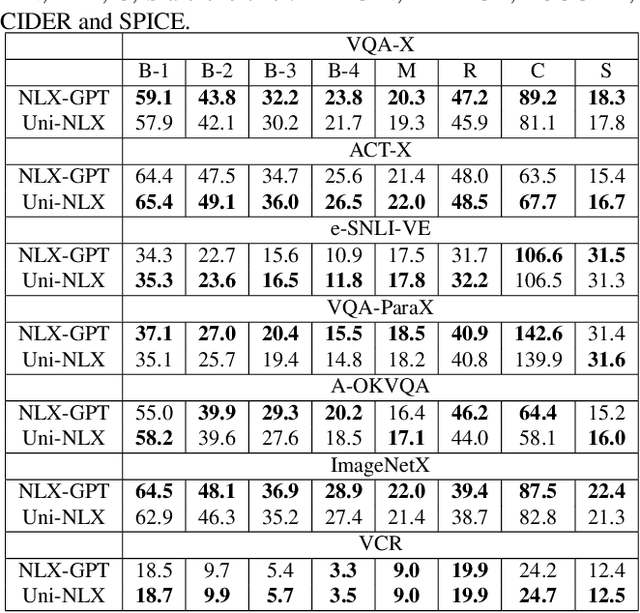
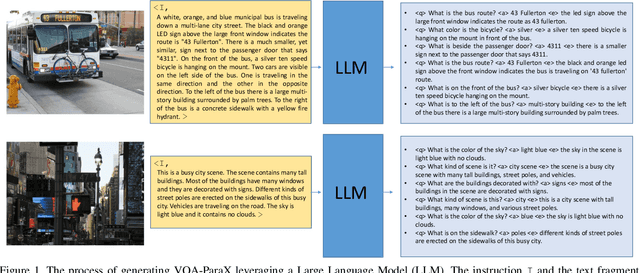
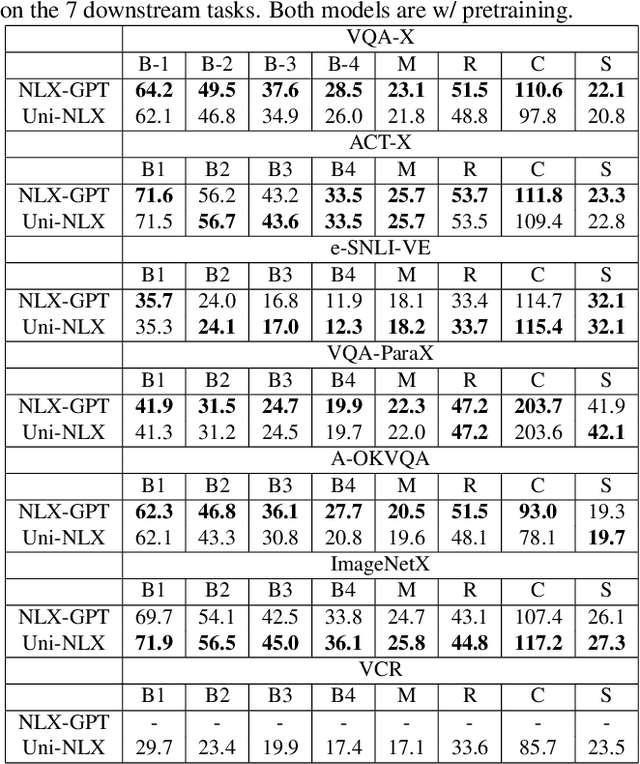
Abstract:Natural Language Explanations (NLE) aim at supplementing the prediction of a model with human-friendly natural text. Existing NLE approaches involve training separate models for each downstream task. In this work, we propose Uni-NLX, a unified framework that consolidates all NLE tasks into a single and compact multi-task model using a unified training objective of text generation. Additionally, we introduce two new NLE datasets: 1) ImageNetX, a dataset of 144K samples for explaining ImageNet categories, and 2) VQA-ParaX, a dataset of 123K samples for explaining the task of Visual Question Answering (VQA). Both datasets are derived leveraging large language models (LLMs). By training on the 1M combined NLE samples, our single unified framework is capable of simultaneously performing seven NLE tasks including VQA, visual recognition and visual reasoning tasks with 7X fewer parameters, demonstrating comparable performance to the independent task-specific models in previous approaches, and in certain tasks even outperforming them. Code is at https://github.com/fawazsammani/uni-nlx
The STOIC2021 COVID-19 AI challenge: applying reusable training methodologies to private data
Jun 25, 2023Abstract:Challenges drive the state-of-the-art of automated medical image analysis. The quantity of public training data that they provide can limit the performance of their solutions. Public access to the training methodology for these solutions remains absent. This study implements the Type Three (T3) challenge format, which allows for training solutions on private data and guarantees reusable training methodologies. With T3, challenge organizers train a codebase provided by the participants on sequestered training data. T3 was implemented in the STOIC2021 challenge, with the goal of predicting from a computed tomography (CT) scan whether subjects had a severe COVID-19 infection, defined as intubation or death within one month. STOIC2021 consisted of a Qualification phase, where participants developed challenge solutions using 2000 publicly available CT scans, and a Final phase, where participants submitted their training methodologies with which solutions were trained on CT scans of 9724 subjects. The organizers successfully trained six of the eight Final phase submissions. The submitted codebases for training and running inference were released publicly. The winning solution obtained an area under the receiver operating characteristic curve for discerning between severe and non-severe COVID-19 of 0.815. The Final phase solutions of all finalists improved upon their Qualification phase solutions.HSUXJM-TNZF9CHSUXJM-TNZF9C
Leaping Into Memories: Space-Time Deep Feature Synthesis
Mar 29, 2023



Abstract:The success of deep learning models has led to their adaptation and adoption by prominent video understanding methods. The majority of these approaches encode features in a joint space-time modality for which the inner workings and learned representations are difficult to visually interpret. We propose LEArned Preconscious Synthesis (LEAPS), an architecture-agnostic method for synthesizing videos from the internal spatiotemporal representations of models. Using a stimulus video and a target class, we prime a fixed space-time model and iteratively optimize a video initialized with random noise. We incorporate additional regularizers to improve the feature diversity of the synthesized videos as well as the cross-frame temporal coherence of motions. We quantitatively and qualitatively evaluate the applicability of LEAPS by inverting a range of spatiotemporal convolutional and attention-based architectures trained on Kinetics-400, which to the best of our knowledge has not been previously accomplished.
Entropy-Based Feature Extraction For Real-Time Semantic Segmentation
Jul 07, 2022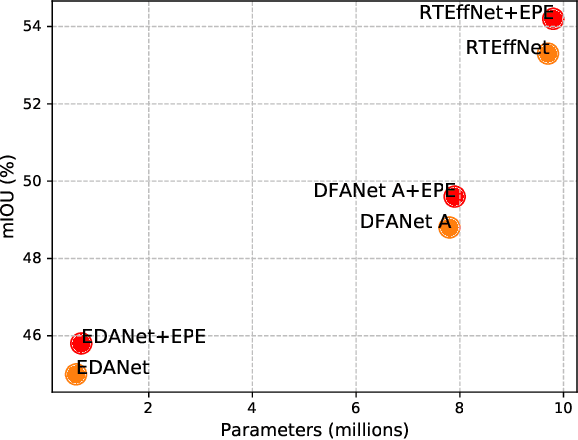
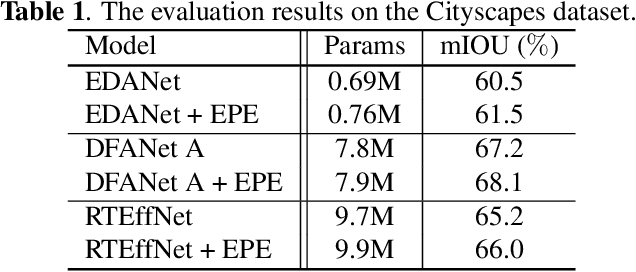
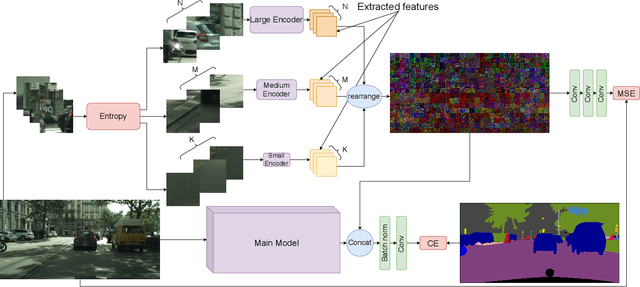
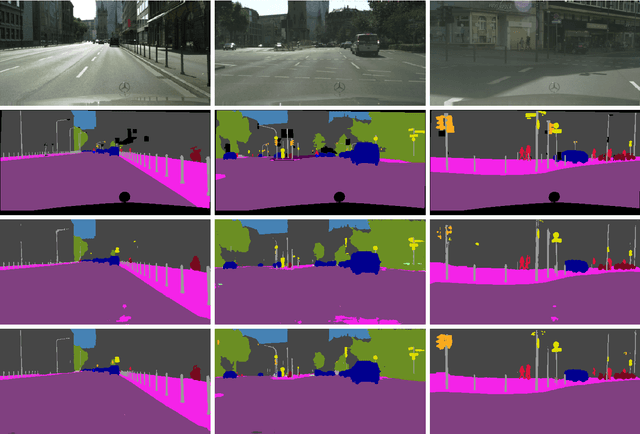
Abstract:This paper introduces an efficient patch-based computational module, coined Entropy-based Patch Encoder (EPE) module, for resource-constrained semantic segmentation. The EPE module consists of three lightweight fully-convolutional encoders, each extracting features from image patches with a different amount of entropy. Patches with high entropy are being processed by the encoder with the largest number of parameters, patches with moderate entropy are processed by the encoder with a moderate number of parameters, and patches with low entropy are processed by the smallest encoder. The intuition behind the module is the following: as patches with high entropy contain more information, they need an encoder with more parameters, unlike low entropy patches, which can be processed using a small encoder. Consequently, processing part of the patches via the smaller encoder can significantly reduce the computational cost of the module. Experiments show that EPE can boost the performance of existing real-time semantic segmentation models with a slight increase in the computational cost. Specifically, EPE increases the mIOU performance of DFANet A by 0.9% with only 1.2% increase in the number of parameters and the mIOU performance of EDANet by 1% with 10% increase of the model parameters.
 Add to Chrome
Add to Chrome Add to Firefox
Add to Firefox Add to Edge
Add to Edge